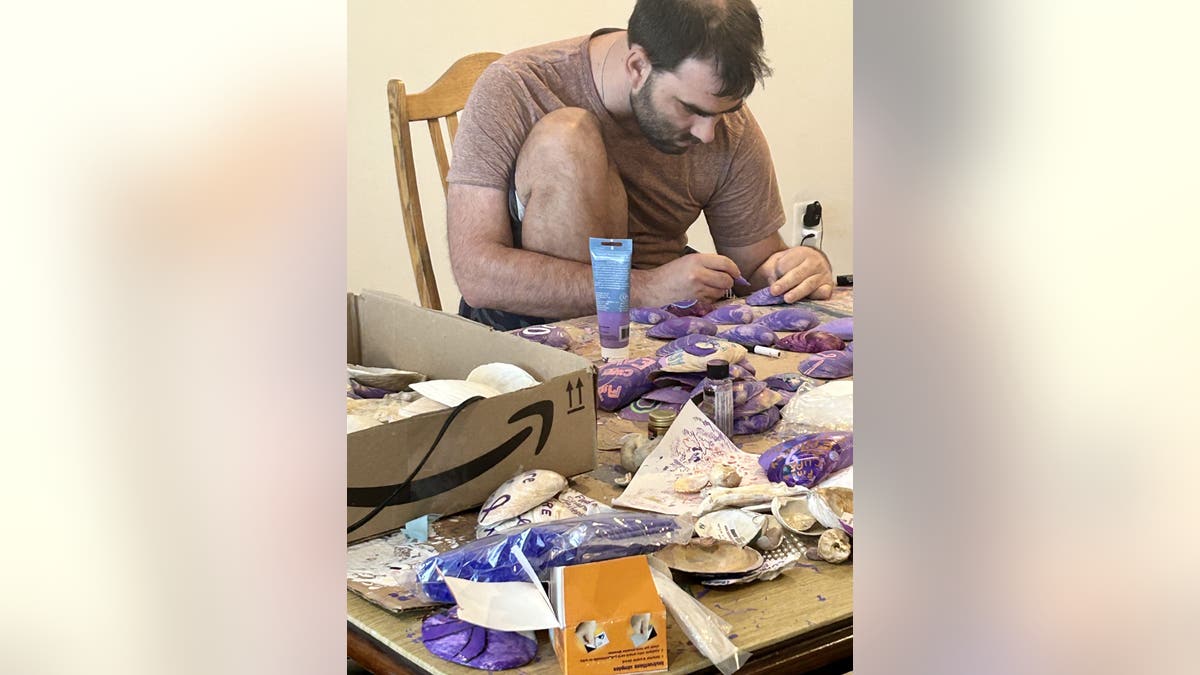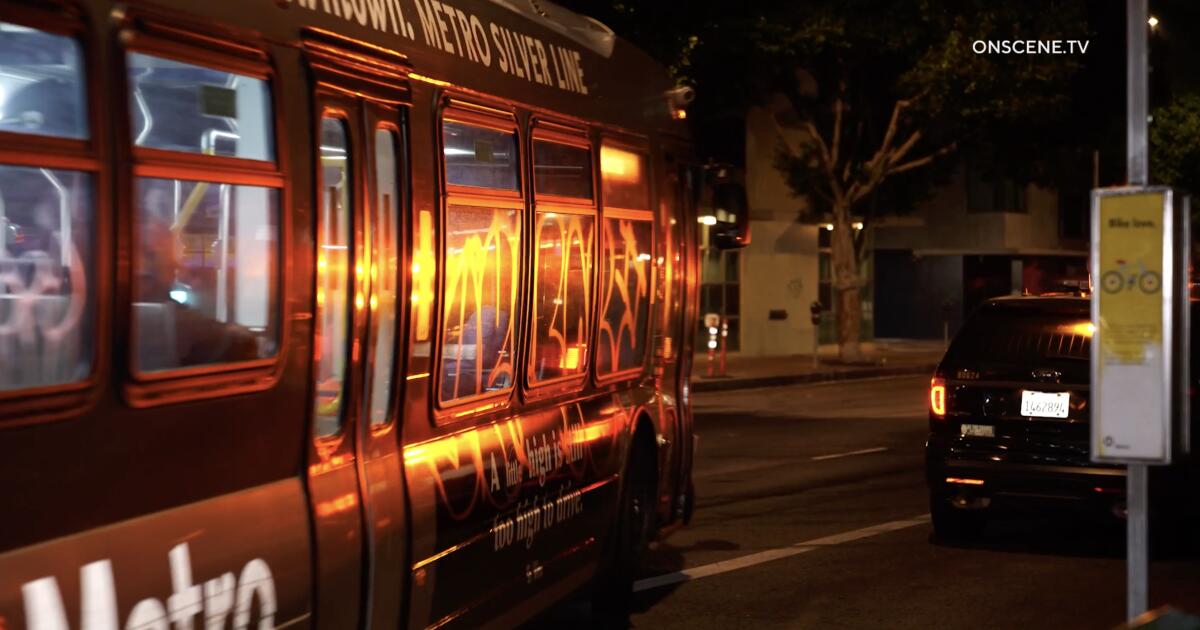World News
Column: How a homophobe repented and became an imperfect LGBTQ+ ally

I remember him well: his toothy smile. His spiky shag haircut. His high cheekbones and ringing laugh.
I also remember what I called the teenager. Queer. Fairy. Even worse names.
We attended Anaheim High in the mid-1990s. I was a senior, he was a freshman. He was one of the few out students on a campus that was overwhelmingly Latino. He endured taunts, epithets and bullying, while cutting down his antagonists with withering insults more often than not.
It didn’t stop me and others.
I learned my homophobia from macho cousins and a father so anti-gay that when my classmate came over to our house for my sister’s party, my dad forbade us to go in the pool, lest something infect us. Homosexuality, my thinking went, was not just an abomination. “They” were a threat to the people I loved — Americans, Mexicans, Catholics, good people — by merely existing.
When my best friend, Art, told me to check my prejudice, I’d spout off a litany of biblical verses — Leviticus this, Genesis that, a hell of a lot of Paul. Nothing could convince me that I should stop my nastiness, let alone accept gay and lesbian people as normal.
An HBO movie changed everything. In Mr. Elder’s biology class, we watched “And the Band Played On,” based on the bestselling book by Randy Shilts about the early days of AIDS. I turned away in disgust at any hint of same-sex affection. But the story — about how the Reagan administration and society at large let a terrible disease spread because it first emerged in the gay community — haunted me.
I might have thought homosexuality to be terrible — but an uncaring government that let people die because of who they were was far worse. A few months later, I went up to my classmate and apologized. I was sincere, but I’ll never forget the understandable skepticism on his face.
I’ve been trying to atone for my sins ever since.
I told my brother when he entered fourth grade to tell me when he and his friends played a schoolyard game called Smear the Queer. One person randomly got the label, and everyone else threw a football at him. I knew it wasn’t a matter of if my brother would join in but when — because I was taught that game, too.
One day, he came home excitedly and reported that he and his friends finally played Smear the Queer. I explained what the word meant and what the game represented, and made him swear to never join again.
Professionally, I went on to slam politicians and groups that try to deny LGBTQ+ people their rights and dignity. Today, I have close LGBTQ+ friends and still get in heated debates with loved ones about their latent and overt homophobia.
I am an imperfect ally, though. I cannot erase the hurt I inflicted before, so I remember those dark days to remind myself that I can always do better.
That’s why a recent poll done for The Times by NORC at the University of Chicago and paid for by the California Endowment brought me some hope about this country’s long, painful journey toward accepting LGBTQ+ people — and was also a gut check on how much work there still is to do.

Christians hold signs as they gathered to pray and protest against the Dodgers’ inclusion of the Sisters of Perpetual Indulgence in their Pride Night program at Dodger Stadium in 2023.
(Brian van der Brug/Los Angeles Times)
The survey was a sequel of sorts to a pioneering 1985 Times project asking people how they felt about homosexuality. The differences between then and now are stark. Back then, 73% felt gay and lesbian relationships were wrong, which an accompanying Times story noted was almost unchanged from a similar 1973 Gallup poll. This most recent poll? Just 28% felt that way.
In 1985, 51% of respondents thought there should be workplace protections for gay and lesbian people. Today, the number is 77%. The older poll showed that 35% were “uncomfortable around gays.” This time around, the question wasn’t even asked.
The 1985 Times study was released with no photos or comment. This time around, we published our findings with moving essays by my current and former LGBTQ+ colleagues. The poll and essays were part of a project called “Our Queerest Century” that is live on our website and will appear in print as a special section June 23.
These surveys show that beliefs do change with time and exposure. But while there’s more acceptance of gay and lesbian people today, a new intolerance has emerged. The 1985 poll didn’t ask about transgender people. The Times/NORC poll did — and the results are discouraging.
More than a third said they would be very or somewhat upset if their child came out as gay or lesbian (in 1985, the figure was 89%). But if the child came out as trans or nonbinary, the percentage increased to 48%. When it came to letting people “[live] their lives as they wish,” only 19% “strongly or somewhat disapproved” if the person was gay or lesbian. Trans or nonbinary? 31%.
Even more telling was a question about whether increased attention on trans and nonbinary people in the media and politics was good or bad. Only 16% thought it was good, while 40% thought it was bad (42% answered “neither”).
The poll unsurprisingly shows that politics and religion correlate with people’s opinions on LGBTQ+ issues. But I also feel that a lack of familiarity plays a huge role. While 72% of American adults in the Times/NORC survey said they knew someone who identified as gay or lesbian, only 27% said the same about transgender or nonbinary people. When you have a come-to-Jesus moment with someone you’ve been taught to see as “different,” you quickly realize how foolish you are.
Case in point: me, again.
A decade after my shameful behavior toward my Anaheim High classmate, I read a powerful column by Times sportswriter Mike Penner that revealed he would return from vacation as Christine Daniels.
“I am a transsexual sportswriter,” Penner wrote. “It has taken more than 40 years, a million tears and hundreds of hours of soul-wrenching therapy for me to work up the courage to type those words.”
I was so moved that I sent a note of appreciation through a mutual friend. To my surprise and delight, Daniels wanted to meet me to talk about dealing with sudden fame. I was then at the OC Weekly, and The Times had featured me and my column, “¡Ask a Mexican!”, leading to an avalanche of attention.
I was nervous, and not just about meeting a writer whose work I had long admired. I didn’t know anyone who identified as transsexual and worried that I would offend Daniels by asking an inappropriate question or using the wrong name or pronoun.

Gregory Winfrey, left, and Benedicto Barnachea, security guards with Allied Universal, raise a Pride flag over the Kenneth Hahn Hall of Administration in downtown Los Angeles in 2023.
(Gary Coronado/Los Angeles Times)
At a panini spot in Old Towne Orange, Daniels quickly disabused me of my low-key transphobia. I found myself focusing on the person before me: Kind. Hilarious. Brilliant. Happy. In the Weekly, I continued to proudly bash the ghouls who ridiculed Daniels, all the way to the sad day in 2009 when Mike Penner, who had returned to using that byline in The Times, died by suicide.
Today, as city councils reject calls to fly rainbow flags during Pride Month and school boards ban books and curricula that touch on anything LGBTQ+, as adults protest drag time story hours in the name of protecting children and hurl invectives at drag nuns while mocking the rise of “Latinx,” I remember my journey from hatred to humility.
I asked Bamby Salcedo, president and chief executive of the TransLatin@ Coalition, about the best way to change closed hearts and minds.
It’s not “about doing a training or checking a DEI box” she said, referring to diversity, equity and inclusion; it’s about having difficult conversations from a place of love, “because hate doesn’t win.”
A heartfelt push back to someone’s anti-LGBTQ+ attitudes, Salcedo said, can “put out that seed of change. And if you plant it, la cosecha sale [the harvest comes].”
I remind myself that people can change — and those who’ve experienced a road to Damascus moment must urge others to follow our path.
The most avoidable sin is ignorance, after all, and all sinners must repent. Take it from one.
World News
New Jersey man with epilepsy uses hand-painted seashells to help find a cure

Greater epilepsy awareness could be as simple as a walk on the beach, thanks to one New Jersey man.
Kyle Adamkiewicz, 33, has lived with epilepsy since being diagnosed at age 6. He is now combining his love of art with the power of nature to help bring his seizure disorder into the spotlight.
In Oct. 2022, Adamkiewicz began collecting seashells from the New Jersey shore, then painting and decorating them with heartfelt messages in search of a cure. He places his works of art along the seaside boardwalks in the hopes that they will inspire strangers to spread the word — and the shells.
OHIO WOMAN WITH EPILEPSY FINDS SAFETY WITH HER SERVICE DOG
“It started with just painting a few shells, and I figured no one would find them,” Adamkiewicz said in an interview with Fox News Digital.
“And then I saw people posting them online, and writing so many good and positive comments about the shells and about finding a cure for epilepsy. That motivated me to keep making more and more and more.”

Kyle Adamkiewicz, shown above, now 33, has lived with epilepsy since he was diagnosed at age 6. He is combining his love of art with the power of nature to help raise awareness of his disease. (Adamkiewicz family)
“And now they have been around the entire world.”
Adamkiewicz doesn’t drive, so his parents — Chuck and Laurie Adamkiewicz — drive him to place his shells.
“We have shells with us in the car all the time, and he places them in different locations, different towns,” his mother told Fox News Digital.
Adamkiewicz estimates that he’s painted some 1,100 shells so far.
Many include messages about finding a cure for epilepsy, but he has also created themed designs for various occasions, like Shark Week and Halloween.

Adamkiewicz has painted over 1,000 shells so far. “Our entire living room consists of nothing but shells and paint,” joked Adamkiewicz’s mother. (Adamkiewicz family)
“Our entire living room consists of nothing but shells and paint,” joked Adamkiewicz’s mother.
In addition to a hand-painted design, each shell contains Adamkiewicz’s initials, the year he decorated it and a QR code.
When people find the shells and scan the QR code, it takes them to a website. From there, they can access Adamkiewicz’s Facebook group, his Instagram account and a GoFundMe page set up to help raise funds for people to get “seizure alert” dogs.
THE GIRL WHO CAN’T SMILE: HOW A RARE DISORDER BECAME A YOUNG WOMAN’S ‘GREATEST GIFT’
It also links to the Epilepsy Foundation website, where people can learn what to do if they witness someone having a seizure.
“Most people don’t really know how to handle someone if they’re having a seizure,” Adamkiewicz told Fox News Digital. “They just turn their back and walk the opposite way.”

In addition to a hand-painted design, each shell contains Adamkiewiczs’s initials, the year he decorated it and a QR code. (Adamkiewicz family)
“One out of 26 people in the world have epilepsy, but it’s basically a hidden disease that nobody really wants to know about.”
The Adamkiewicz family has a map of the world hanging on the wall — with pushpins to mark where the shells have been found, they told Fox News Digital.
In addition to locations across the U.S., shells have also been scanned in Mexico City, Greece, Italy, Panama, Canada, Nova Scotia, France, South Korea and Germany, Adamkiewicz said.
“One out of 26 people in the world have epilepsy, but it’s basically a hidden disease.”
“People will find the shells and take them to those places,” Adamkiewicz said. “And sometimes people will ask me for shells to take to wherever they are traveling.”
He’s also partnered with the hospital to get kids with epilepsy involved in his project, bringing shells in for them so they can paint their own designs.
Touching lives
Beyond helping to find a cure, Adamkiewicz has a goal of reducing bullying of people with epilepsy.

Adamkiewicz is pictured with his mother, Laurie Adamkiewicz. In April, he underwent a procedure to implant a responsive neurostimulation (RNS) device in his brain, which will gather data about his seizure activity. (Adamkiewicz family)
“When I was growing up, if my parents or brother weren’t there, I was always made fun of in school and in the neighborhood,” Adamkiewicz said. “Especially right after I had a seizure — the kids would just stare at me and make fun of me.”
He went on, “I want people to know it’s OK to be friends with someone with epilepsy.”
OHIO BOY, 8, PREPARES FOR BLINDNESS: ‘IT’S HEARTBREAKING,’ HIS MOM SAYS
At one point, during second and third grade, he estimates that he was having 100 seizures per day.
“It’s been a very hard and lonely life for Kyle, and very painful to see as a mother and father,” Laurie Adamkiewicz added.
The goal, she said, is that the shells will help to make life a little easier for those with epilepsy — and their families.

Adamkiewicz said his seashell project has been a therapeutic endeavor for him. “If it’s been a really bad day, that’s mostly what I’ll be doing,” he said. (Adamkiewicz family)
Adamkiewicz’s mother recalled a man who posted about a personal experience on the Facebook group.
“His son had passed away, and the man goes to the ocean every morning to say good morning to his son,” she said. “And there was the epilepsy shell, and he said he started crying. He said it was just like a gift to him.”
She added, “You never know whose lives you’re touching.”
Taking control
Since age 12, Adamkiewicz has been a patient at NYU Langone’s Comprehensive Epilepsy Center, one of the largest programs in the nation, where he’s had a series of brain surgeries.
NEW JERSEY TWINS RECEIVE MATCHING HEART SURGERIES AFTER MARFAN SYNDROME DIAGNOSIS: ‘A BETTER LIFE’
In April, he underwent a procedure to implant a responsive neurostimulation (RNS) device in his brain, which will gather data about his seizure activity.
Neurosurgeon Peter Rozman, M.D., performed the surgery alongside his mentor, Werner K. Doyle, M.D., Adamkiewicz’s longtime doctor.

Adamkiewicz and his mom, Laurie Adamkiewiz, are pictured with some of his painted shells. (Adamkiewicz family)
“This system has the capacity to actually record brain activity in the form of electrical waves that detect when the seizures start, so it can deliver an impulse to the brain at that time, with the goal of aborting the seizure,” Rozman said in an interview with Fox News Digital.
The data collected by the device is sent to the neurologist, who uses that information to program the device to better capture and treat the seizures, he said.
“Over time, people see more and more improvement in their seizures,” Rozman said.
CLICK HERE TO GET THE FOX NEWS APP
Rozman praised Adamkiewicz’s seashell project, emphasizing the importance of increasing awareness of the condition.
“And it gives him an outlet, too,” the doctor said. “Having other people to talk about your condition with and being part of a community can be very helpful.”

Each shell contains a QR code that a person can scan to access information, resources and fundraisers for epilepsy. (Adamkiewicz family)
In a way, Rozman said, Adamkiewicz is turning his epilepsy into a good thing.
“It’s beneficial on both sides — for raising awareness and also allowing Kyle to have more control and to drive the story,” he said.
CLICK HERE TO SIGN UP FOR OUR HEALTH NEWSLETTER
“It can be such a devastating thing to have to deal with on a daily basis, and having some sort of license and control over that is really important.”
Adamkiewicz agreed that his project has been a therapeutic endeavor for him.
“We want to teach people how to be kind, and how to help.”
“If it’s been a really bad day, that’s mostly what I’ll be doing,” he said.
“Like earlier today, I was painting some shells and had my ear buds in, just listening to some music. I’m just so focused on painting the shells that I zone everybody else out.”

Adamkiewicz’s shells have been found in many cities and countries around the world, including in Paris, France. (Adamkiewicz family)
Adamkiewicz and his mother are also working on a children’s book to teach kids more about epilepsy and what to do if someone is having a seizure.
“When someone has a seizure, it can be frightening to other children,” said Laurie Adamkiewicz mother.
For more Health articles, visit www.foxnews/health
“So the goal is to get some information out there, to take the stigma away from the person who has epilepsy … We want to teach people how to be kind, and how to help.”
World News
26,000 Evacuate as Wildfire Spreads in Northern California

When a fast-moving wildfire began marching across thousands of acres of Butte County on Tuesday, David Pittman didn’t panic. He packed up his family, including their 90-pound African sulcata tortoise, and drove to his sister’s house across town in Oroville, Calif.
That’s where he’s planning to stay for the next several days — at least until firefighters get a handle on the Thompson fire, which has engulfed several homes and vehicles and has prompted about 26,000 people to evacuate, including Mr. Pittman.
“I hate to say it, but we’re experienced in this kind of stuff,” he said on Wednesday.
Mr. Pittman, 70, is the mayor of Oroville, a small Northern California town that has roots in the Gold Rush and is tucked near the state’s second-largest reservoir about 65 miles north of Sacramento. He is also a retired local fire chief who has watched his region face calamity after calamity in recent years.
In 2017, officials ordered residents to flee Oroville as thundering rapids from an emergency spillway at nearby Oroville Dam threatened to overwhelm the town. The next year, in 2018, one of the deadliest wildfires in American history, the Camp fire, killed 85 people and nearly wiped the town of Paradise — about 20 miles north of Oroville — off the map.
In 2020, a record-breaking fire season left millions of acres scorched across California, including “right into the city of Oroville,” Mr. Pittman said. In 2021, the second largest fire ever recorded in California, the Dixie fire, burned an area larger than New York, Los Angeles, Chicago and Dallas combined. It was sparked by damaged PG&E power lines near the waterway that bisects Oroville, the Feather River.
The various disasters, experts have said, are symptoms of widening climate extremes, which have plunged the West into near-constant whiplash between catastrophic floods and raging wildfires. This year, climate scientists warned that a hot summer in the West could dry out vegetation that grew abundant during a wet winter, turning what was lush green into prime tinder and making for a hazardous fire season.
For many Oroville residents at evacuation centers on Wednesday, fleeing from wildfires is becoming routine.
Sitting in the 106 degree heat outside a church shelter a few miles from the fire, Vernon Englund, 78, said this was the third time he had evacuated in four years from fires.
“We’ve been evacuated enough times that we keep to-go bags, and I just hooked up my R.V. and took off,” he said. “But I probably should have been more worried than I was, because the fire got closer than I ever thought that it would,” he added.
For Ashlie Boocks, 22, who had driven to the church shelter on Tuesday after seeing “ash the size of my palm” drifting from the sky, this was her second evacuation in three years.
On Tuesday night, she said, she drove to a spot where she could see the whole mountainside glowing with flames. “It was lit up and it was just horrible,” she said. “You’re seeing propane tanks exploding. You can hear them.”
“This is not something that should be common,” she added.
Pacific Gas & Electric, California’s biggest power utility, shut off power this week in some parts of Northern California, including Butte County, because of the increased fire risk, including nearly 2,000 homes and businesses in eight counties on Tuesday, The Sacramento Bee reported.
The Thompson fire, which erupted on Tuesday morning, remains small compared with the major fires in past years; as of Wednesday night, it had burned nearly 3,600 acres of mountainous terrain near Lake Oroville and was 7 percent contained, according to Cal Fire, the state’s firefighting agency. So far, eight injuries have been reported as a result of the blaze. And the authorities have not yet said how many structures have been damaged, though the fire has consumed homes and vehicles, based on news coverage.
Several state water facilities were affected by the evacuation orders, but there was no risk to Oroville Dam, which is the tallest dam in the United States, the California Department of Water Resources said on Tuesday night.
Mr. Pittman noted that the extreme heat baking the state this week, along with unpredictable winds, would make containing the blaze particularly difficult. Temperatures in Oroville were expected to reach 110 degrees on Wednesday and even higher toward the end of the week, according to the National Weather Service.
“We have up-and-down breezes that are pushing the fire around,” he said. “The fuels are ready to burn. So the crews have a tough job.”
He added, “I’m standing outside, and I can feel the heat through my T-shirt.”
Evacuation centers were full, he said. A large fireworks display that typically draws more than 10,000 people to Oroville was canceled to ensure that emergency workers could focus on responding to the fire.
Oroville officials on Wednesday temporarily banned the use of fireworks of any kind in the city, but stopped short of prohibiting legal sales, which local nonprofit groups have long used to raise funds in the summer. In Butte County, fireworks are illegal except in the cities of Oroville, Gridley and Biggs, where those with a “safe and sane” seal can be used.
“The last thing we need is somebody who’s purchased fireworks from a local fire stand going out and doing something stupid,” Sheriff Kory Honea of Butte County said at a news conference late Tuesday. “Don’t be an idiot, cause a fire and create more problems for us.”
Fireworks may not be as visually impressive as usual, anyway: The mayor said that the smoke in downtown Oroville was at one point so thick that he couldn’t see his hand in front of his face. Some evacuees have gathered there with trailers or recreational vehicles, but many businesses were closed.
Brian Wong said that his restaurant, Union Patio Bar and Grill, would remain open with reduced staffing because workers were dealing with their own evacuation orders. Evacuees would receive a discount, he said.
“We’ll just do what we can,” he said. “Today is about serving the community.”
But Mr. Wong, 53, said he wouldn’t be on site. Instead, he plans to stay at his home with his father-in-law, where they hope to protect the property by extinguishing any flames that get close.
Although his house is under an evacuation order and most of his neighbors have fled, Mr. Wong said that he was reluctant to do so after seeing residents of Paradise and other communities struggle to obtain insurance payments or other emergency aid.
“A lot of those cases are still not settled,” he said. “A lot of people that have properties — they’re not going to get what they were owed. So I really didn’t want to leave.”
He added that many of his neighbors had been required to pay skyrocketing insurance premiums, while others had simply gone uninsured as companies dropped coverage in many areas of California.
Mr. Wong, who has lived full-time in Oroville for more than 25 years, said that he and his family had taken precautions recommended by fire experts to clear brush on the property. He had also packed his truck full of valuables and said he was ready to leave if necessary.
Still, as of Wednesday afternoon, he was hunkering down and watching the plumes of smoke, hoping that his neighborhood would be spared.
Amanda Holpuch, Jonathan Wolfe and Yan Zhuang contributed reporting.
World News
‘I’m running’, Biden says, as pressure mounts on campaign

By Gareth Evans and Kayla Epstein, BBC News, Washington & New York
 EPA
EPAUS President Joe Biden worked to calm senior Democrats and staff on his campaign on Wednesday, as reports suggested he was weighing his future after his disastrous debate with Donald Trump last week.
Mr Biden held a closed-door lunch with Vice-President Kamala Harris at the White House as speculation mounted over whether she would replace him as the party’s candidate in November’s election.
The pair then joined a call with the broader Democratic campaign where Mr Biden made clear he would remain in the race and Ms Harris reiterated her support. “I’m the nominee of the Democratic Party. No one’s pushing me out. I’m not leaving,” he told the call, a source told BBC News.
That same phrase was repeated in a fundraising email sent out a few hours later by the Biden-Harris campaign. “Let me say this as clearly and simply as I can: I’m running,” Mr Biden said in the email, adding that he was “in this race until the end”.
Questions have been swirling around whether the 81-year-old will continue with his campaign following the debate with Trump, which was marked by verbal blanks, a weak voice and some answer which were difficult to follow. It sparked concern in Democratic circles around his fitness for office and his ability to win the election.
Pressure on Mr Biden to drop out has only grown in the days since as more polls indicate his Republican rival’s lead has widened. A New York Times poll conducted after the debate, which was published on Wednesday, suggested Trump was now holding his biggest lead yet at six points.
And a separate poll published by the BBC’s US partner CBS News suggested Trump has a three-point lead over Biden in the crucial battleground states. That poll also indicated the former president was leading nationally.
The damaging polling has been compounded by some Democratic donors and lawmakers publicly calling on the president to stand aside. Ramesh Kapur, an Indian-American industrialist based in Massachusetts, has organised fundraisers for Democrats since 1988.
“I think it’s time for him to pass the torch,” Mr Kapur told the BBC. “I know he has the drive, but you can’t fight Mother Nature.”
And two Democrats in Congress also called for a change at the top of the party’s ticket. The latest, Representative Raul Grijalva of Arizona, told the New York Times it was time for Democrats to “look elsewhere”.
Despite this, the White House and the Biden campaign have vehemently denied reports he is actively weighing his future and say he is committed to defeating Trump for a second time on 5 November.
The New York Times and CNN reported on Wednesday that Mr Biden had told an unnamed ally he was evaluating whether to stay in the race.
Both reports said the president had told the ally he was aware his re-election bid was in danger and his forthcoming appearances – including an ABC News interview and a Friday rally in Wisconsin – were hugely important to his campaign.
A spokesperson rejected the reports as “absolutely false”, shortly before White House Press Secretary Karine Jean-Pierre faced a barrage of questions about Mr Biden’s commitment to the race.
She said the reports he may drop out were untrue: “We asked the president [and] the president responded directly… and said ‘no, it is absolutely false’. That’s coming direct from him.”
Mr Biden met 20 Democratic governors from around the country, including California’s Gavin Newsom and Michigan’s Gretchen Whitmer, later on Wednesday. Both have been tipped as potential replacements if Mr Biden were to stand aside.
“The president has always had our backs, we’re going to have his back as well,” Maryland Governor Wes Moore told reporters after the meeting.
New York Governor Kathy Hochul said the two dozen governors who had just met the president pledged their support and that Mr Biden had vowed he was “in it to win it”.
But Ms Harris is still considered the most likely replacement. The 59-year-old has been hampered by poor approval ratings, but her support has increased among Democrats since the Biden-Trump debate.
The vice-president gave an immediate interview on CNN after the debate, projecting calm as she expressed full support for the president.
“She’s changing nothing,” a source close to Ms Harris told BBC News, adding that she would continue to hit the road on behalf of the campaign.
“She has always been mindful to be a good partner to the president,” said Jamal Simmons, Ms Harris’ former communications director.
“The people who ultimately will make the decision about who the nominee should be mostly are people who are pledged to him. Her best role is to be a partner to him.”
Members of the Democratic National Committee are charged with voting to officially make President Biden the party’s nominee at the August convention, putting him on the ballot nationwide.
One member, who has spoken to other delegates and requested anonymity to speak frankly about sensitive discussions, told the BBC that the nomination should go to Vice-President Harris if Mr Biden opted not to run.
“If we open up the convention, it will cause pure chaos that will hurt us in November,” they said.
A report by the Washington Post, meanwhile, said Mr Biden and his team recognised that he must demonstrate his fitness for office in the coming days.
He appeared at a Medal of Honor ceremony on Wednesday, and has planned trips to Wisconsin and Philadelphia later in the week.
Courtney Subramanian, Adam Levy and Brajesh Upadhyay contributed to this report
-

 African History5 years ago
African History5 years agoA Closer Look: Afro-Mexicans 🇲🇽
-

 African History5 months ago
African History5 months agoBlack History Facts I had to Learn on My Own pt.6 📜
-

 African History5 years ago
African History5 years agoA Closer Look: Afro-Mexicans 🇲🇽
-

 African History1 year ago
African History1 year agoMajor African Tribes taken away during the Atlantic Slave Trade🌍 #slavetrade #africanamericanhistory
-

 African History1 year ago
African History1 year agoCameroon 🇨🇲 World Cup History (1962-2022) #football #realmadrid #shorts
-

 African History5 months ago
African History5 months agoBlack History Inventors: Mary Kenner 🩸
-

 African History1 year ago
African History1 year agoPROOF AFRICAN AMERICANS AIN'T FROM AFRICA DOCUMENTED EVIDENCE
-

 African History1 year ago
African History1 year agoNo African pre-Columbus DNA? 🤯🤯 #history #mesoamerica #mexico #african































